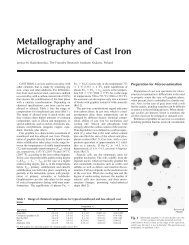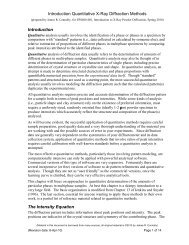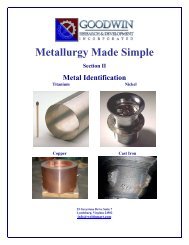ITP Metal Casting: 2002 Metal Casting Industry of the Future ...
ITP Metal Casting: 2002 Metal Casting Industry of the Future ...
ITP Metal Casting: 2002 Metal Casting Industry of the Future ...
Create successful ePaper yourself
Turn your PDF publications into a flip-book with our unique Google optimized e-Paper software.
INDUSTRY OVERVIEW<br />
Everyday tasks such as turning on a light, starting a car, or using a computer would not be possible<br />
without metal casting. The metal casting industry has been integral to U.S. growth and has helped<br />
<strong>the</strong> U.S. become <strong>the</strong> world benchmark in fields such as manufacturing, science, medicine, and<br />
aerospace. Now this small business industry continues to fuel <strong>the</strong> nation’s prosperity and national<br />
defense into <strong>the</strong> 21 st Century.<br />
<strong>Metal</strong> <strong>Casting</strong> In Brief<br />
<strong>Metal</strong> casting enables <strong>the</strong> production <strong>of</strong> simple and complex parts that meet a wide variety <strong>of</strong><br />
needs. Nearly all manufactured goods contain one or more cast components. Major end-uses<br />
include power generation equipment, defense systems and machinery, motor vehicles,<br />
transportation equipment, oil field machinery, pipelines, industrial machinery, construction materials,<br />
and o<strong>the</strong>r products vital to our economic and national security. Oil field machinery and equipment<br />
sales alone represent $259 million in casting sales per year. 5 Exhibit 2 illustrates raw material<br />
supplies and end use markets for metal castings.<br />
Exhibit 2<br />
<strong>Metal</strong> <strong>Casting</strong> Supply and End-Use Markets<br />
Copper<br />
2%<br />
Ductile Iron<br />
34%<br />
Steel<br />
6%<br />
Aluminum<br />
15%<br />
Zinc<br />
1.6%<br />
Gray Iron<br />
40%<br />
O<strong>the</strong>r<br />
1.4%<br />
Municipal <strong>Casting</strong>s<br />
3%<br />
Farm Equipment<br />
3%<br />
Construction, Mining<br />
& Oil field Mach. 6%<br />
Pipe & Fittings<br />
15%<br />
Railroad<br />
5%<br />
Automotive & Light<br />
Truck 35%<br />
Valves<br />
5%<br />
O<strong>the</strong>r<br />
23%<br />
Int. Comb. Engines<br />
5%<br />
Source: U.S. Department <strong>of</strong> Commerce, Bureau <strong>of</strong> Census, Current Industrial Reports MA331E(00) and MA331A(00)-1<br />
and American Foundry Society Facts & Figures About <strong>the</strong> U.S.Foundry <strong>Industry</strong>,<br />
http://www.afsinc.org/trends/factsandfigures.htm<br />
Exhibit 3 describes <strong>the</strong> various methods used to cast metals. The basic metal casting process<br />
consists <strong>of</strong> pouring or injecting molten metal into a mold or die containing a cavity <strong>of</strong> <strong>the</strong> desired<br />
shape. The most commonly used method for small-and medium-sized castings is green sand<br />
molding, accounting for approximately 60% <strong>of</strong> castings produced. O<strong>the</strong>r methods include die<br />
casting, shell molding, permanent molding, investment casting, lost foam casting, and squeeze<br />
casting. Markets for metal castings are increasingly competitive and casting customers are placing<br />
greater emphasis on high-quality, competitively priced castings. There is increasing demand for<br />
lighter-weight, high-strength ferrous and nonferrous cast metal components as well as castings that<br />
meet demanding design specifications. <strong>Casting</strong> processes must continually evolve and improve to<br />
remain competitive in today’s marketplace.<br />
5<br />
Lessiter, Michael J. Modern <strong>Casting</strong> “Oil Field Equipment & Machinery,” November <strong>2002</strong>, pg. 36.<br />
5








